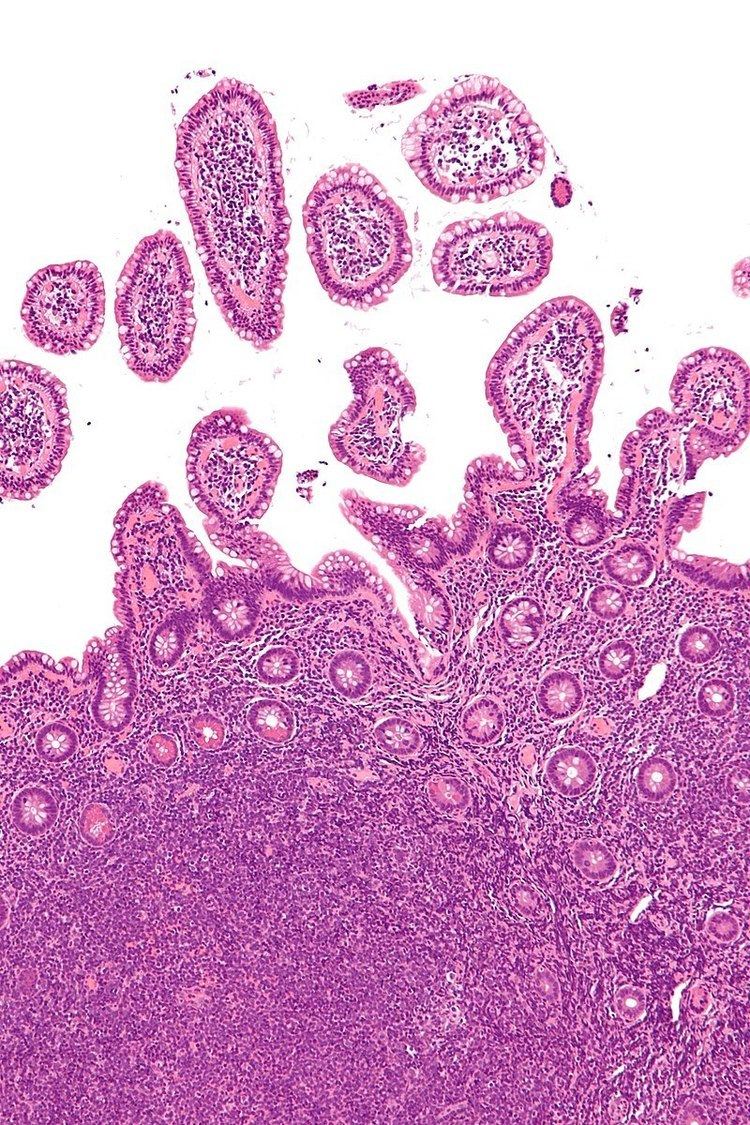Synonyms non-Hodgkin disease ICD-9-CM 200, 202 OMIM 605027 | ICD-10 C82-C85 ICD-O 9591/3 | |
 | ||
Specialty hematology and oncology | ||
Non-Hodgkin lymphoma (NHL) is a group of blood cancers that includes all types of lymphoma except Hodgkin's lymphomas. Symptoms include enlarged lymph nodes, fever, night sweats, weight loss, and tiredness. Other symptoms may include bone pain, chest pain, or itchiness. Some forms are slow growing while others are fast growing.
Contents
- Signs and symptoms
- Causes
- HIVAIDS
- Treatment
- Epidemiology
- Non Hodgkin lymphoma
- Subtypes of non Hodgkin lymphoma
- Terminology
- References
Lymphomas are types of cancer that develops from lymphocytes, a type of white blood cell. Risk factors include poor immune function, autoimmune diseases, Helicobacter pylori infection, hepatitis C, obesity, and Epstein-Barr virus infection. The World Health Organization (WHO) classifies lymphomas into five major groups, including one for Hodgkin's lymphoma. Within the four groups for NHL there are over 60 specific types of lymphoma. Diagnosis is by examination of a bone marrow or lymph node biopsy. Medical imaging is done to help with cancer staging.
Treatment depends on if the lymphoma is slow or fast growing and if it is in one area or many areas. Treatments may include chemotherapy, radiation, immunotherapy, targeted therapy, stem cell transplantation, surgery, or watchful waiting. If the blood becomes overly thick due to antibodies, plasmapheresis may be used. Radiation and some chemotherapy, however, increase the risk of other cancers, heart disease or nerve problems over the subsequent decades.
In 2013 about 2.96 million people had non-Hodgkin lymphoma and 226,000 died. In the United States 2.1% of people are affected at some point in their life. The most common age of diagnosis is between 65 to 75 years old. The percentage of people who survive five years in the United States is 71%.
Signs and symptoms
The signs and symptoms of non-Hodgkin's lymphoma vary depending upon its location within the body. Symptoms include enlarged lymph nodes, fever, night sweats, weight loss, and feeling tired. Other symptoms may include bone pain, chest pain, or itchiness. Some forms are slow growing while others are fast growing. Enlarged lymph nodes may cause lumps to be felt under the skin when they are close to the surface of the body. Lymphomas in the skin may also result in lumps, which are commonly itchy, red or purple. Lymphomas in the brain can cause weakness, seizures, problems with thinking and personality changes.
Causes
The many different forms of lymphoma probably have different causes. These possible causes and associations with at least some forms of NHL include the following:
HIV/AIDS
The Center for Disease Control and Prevention (CDC) included certain types of non-Hodgkin's lymphoma as AIDS-defining cancers in 1987. Immune suppression rather than HIV itself is implicated in the pathogenesis of this malignancy, with a clear correlation between the degree of immune suppression and the risk of developing NHL. Additionally, other retroviruses such as HTLV may be spread by the same mechanisms that spread HIV, leading to an increased rate of co-infection. The natural history of HIV infection has been greatly changed over time. As a consequence, the incidence of non-Hodgkin's lymphoma (NHL) in HIV infected patients has significantly declined in recent years.
Treatment
The most common chemotherapy used is CHOP-R for non-Hodgkin lymphoma.
Epidemiology
In the US, data from 2007–2011 show that there were about 19.7 cases of NHL per 100,000 adults per year, 6.3 deaths per 100,000 adults per year. About 2.1 percent of men and women are diagnosed with NHL at some point during their lifetime, and there were around 530,919 people living with non-Hodgkin lymphoma.
Globally, as of 2010, there were 210,000 deaths, up from 143,000 in 1990.
Non-Hodgkin lymphoma
While consensus was rapidly reached on the classification of Hodgkin lymphoma, there remained a large group of very different diseases requiring further classification. The Rappaport classification, proposed by Henry Rappaport in 1956 and 1966, became the first widely accepted classification of lymphomas other than Hodgkin. Following its publication in 1982, the Working Formulation became the standard classification for this group of diseases. It introduced the term non-Hodgkin lymphoma or NHL and defined three grades of lymphoma.
Subtypes of non-Hodgkin lymphoma
NHL consists of many different conditions that have little in common with each other. They are grouped by their aggressiveness. Less aggressive non-Hodgkin lymphomas are compatible with a long survival while more aggressive non-Hodgkin lymphomas can be rapidly fatal without treatment. Without further narrowing, the label is of limited usefulness for patients or doctors. The subtypes of lymphoma are listed there.
Terminology
Nevertheless, the Working Formulation and the NHL category continue to be used by many. To this day, lymphoma statistics are compiled as Hodgkin's vs non-Hodgkin lymphomas by major cancer agencies, including the US National Cancer Institute in its SEER program, the Canadian Cancer Society and the IARC.
